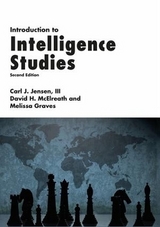
Introduction to Intelligence Studies
Crc Press Inc (Verlag)
978-1-4665-0003-7 (ISBN)
- Titel erscheint in neuer Auflage
- Artikel merken
Introduction to Intelligence Studies provides a comprehensive overview of intelligence and security issues, defining critical terms, and reviewing the history of intelligence as practiced in the United States. Designed in a practical sequence, the book begins with the basics of intelligence, progresses through its history, describes best practices, and explores the way the IC looks and operates today. Each chapter begins with objectives and key terms and closes with questions to test reader assimilation.
The authors examine the "pillars" of the American intelligence system—collection, analysis, counterintelligence, and covert operations—and demonstrate how these work together to provide "decision advantage." The book provides equal treatment to the functions of the intelligence world—balancing coverage on intelligence collection, counterintelligence, information management, critical thinking, and decision-making. It also covers such vital issues as laws and ethics, writing and briefing for the IC, and the emerging threats and challenges that intelligence professionals will face in the future.
Carl J. Jensen III, Ph.D., is the director of the University of Mississippi’s (UM) Center for Intelligence and Security Studies. He also is a member of UM’s Legal Studies Department and serves in an adjunct capacity as a senior behavioral scientist with the RAND Corporation. Dr. Jensen served as a special agent with the Federal Bureau of Investigation (FBI) for 22 years; his FBI career included service as a field agent, a forensic examiner in the FBI Laboratory, and an instructor and assistant chief of the Behavioral Science Unit. He has published extensively and lectured throughout the world. David H. McElreath, Ph.D., has a background that includes service as professor and chair, Department of Legal Studies, University of Mississippi; professor and chair, Department of Criminal Justice, Washburn University; associate professor, Southeast Missouri State University; Colonel, United States Marine Corps; and Law Enforcement and Corrections positions with the Oxford (Mississippi) Police and Forrest County (Mississippi) Sheriff’s Department. He is the author of numerous publications on the criminal justice system. Melissa Graves, J.D., M.A., serves as project coordinator and instructor at the University of Mississippi’s Center for Intelligence and Security Studies. Among her other accomplishments, she and her codeveloper Walter Flaschka have designed and implemented the Days of Intrigue, a realistic practical exercise conducted yearly at UM that involves numerous intelligence community agencies. She is presently pursuing a Ph.D. in history. Ms. Graves has been admitted to the Bars of Texas and Washington.
An Overview of Intelligence
What Is Intelligence?
The Challenge of Defining Intelligence
Information and Intelligence
Types of Intelligence
Functions of Intelligence Agencies
Policymakers and Decision-Makers
Intelligence Foundations in U.S. Government
U.S. Intelligence Community
Purpose of Intelligence
Limitations of Intelligence
History of Intelligence in the United States
Revolutionary War to Civil War
Civil War to World War I
Law Enforcement Intelligence: The Palmer Raids
World War I to Pearl Harbor
World War II
The Cold War
National Security Act of 1947
Early Days of the CIA
Korean War
Creation of the National Security Agency
Evolution of IMINT
Cuba
Vietnam Era
War at Home
Watergate and the Pike and Church Committees
The Carter Years
The Reagan Years: End of Cold War
End of the Soviet Union
Emergence of Terrorism
Espionage in 1980s and 1990s
The Clinton Years
9/11 and Its Aftermath
Intelligence Reform and Terrorism Prevention Act of 2004 and Creation of the Director of National Intelligence
Recent Developments in the Struggle against Terrorism
The IC Today
Designated Federal Agencies and the DNI
Director of National Intelligence
Independent Agencies: CIA
Department of Energy: Office of Intelligence and Counterintelligence
DHS: Office of Intelligence and Analysis
DHS: Coast Guard Intelligence
Department of Justice: FBI
Department of Justice: DEA
Department of State: Bureau of Intelligence and Research
Department of the Treasury: Office of Terrorism and Financial
Intelligence
Military Agencies: Army, Navy, Air Force, and Marines
Military Agencies: Defense Intelligence Agency
Military Agencies: National Geospatial-Intelligence Agency
Military Agencies: National Security Agency
Military Agencies: National Reconnaissance Office
Federal, State, and Local Agencies
Federal Agencies
State and Local Agencies
Private Sector
Collection
Considerations for Collection
Credibility Issues: Vetting the Source
Information: How Much Is Enough?
Protecting Sources and Methods
First Step in Collection—You Need to Have a Plan
Collection Methods: The "INTs"
Human Intelligence
Signals Intelligence
Geospatial Intelligence
Financial Intelligence
Open Source Intelligence
Barriers to Analysis
Murky World of IC
Psychological Barriers
Group Decision-Making
Bureaucratic Barriers: Politics and the Will of the Policymaker
Bureaucratic Barriers: Information Sharing
Security and Sharing: Inherent Tension
Analytical Methods
Critical Thinking
Collaboration
Structured Analytical Techniques
Understanding Our Assumptions: Key Assumptions Check
Considering All Sides of the Issue: Analysis of Competing Hypotheses
Preparing for Whatever Comes: Scenarios
The Emperor’s Clothes Are Fair Game: Contrarian Methods
Analytical Software
Putting It All Together: The Intelligence Cycle
Information and the Origin of the Intelligence Cycle
The Intelligence Cycle
Step One: Planning and Direction
Step Two: Collection
Step Three: Processing
Step Four: Analysis
Step Five: Dissemination
Step Six: Evaluation
Critical Reactions to the Intelligence Cycle
Counterintelligence
Defensive Counterintelligence
Classification Systems
Security Clearances
Counterintelligence Operations
Offensive Counterintelligence
Catching Spies in the United States
International Operations
Disinformation
Counterintelligence Operations Today
Covert Operations
Covert Operations
Clandestine Operations
Deception Operations
Recent History of Covert and Clandestine Operations by the United States
Military Covert Operations
Legal Requirements upon the President to Report Intelligence Operations
Covert Operations and the War on Terror
Are Covert Operations a Good Idea?
Constitutional Mandates—Overview of Executive, Legislative, and Judicial Roles
Legal Origin of the Intelligence Community
Intelligence and International Law
Targeting and Assassination
Fourth Amendment: Right to Privacy
History of FISA
28 Code of Federal Regulations 23
First Amendment Issues and Intelligence
USA PATRIOT Act
Intelligence Reform and Terrorism Prevention Act
Terrorism and Legal Proceedings
Classified Information Procedures Act
Ethics
Writing and Briefing for the Intelligence Community
Writing
Types of Intelligence Writing
Writing for an Audience
How to Write Intelligence Products
Good versus Bad Intelligence Writing
The Art of Writing
The Writing Process
Briefing
Basics of Public Speaking
Briefing Preparation
The Briefing
Military Intelligence
Purpose of Military Intelligence
Types of Military Intelligence
Command and Control
The Military Intelligence Cycle
Evolution of Military Intelligence
Current State of Military Intelligence
Intelligence Role of the Commander
Role of the Military Intelligence Officer
The "2 Section"
Military Intelligence Assets
Intelligence Preparation of the Battlefield and Today’s Threat Structure
Military Intelligence within the National Defense Structure
United States Army
United States Navy
United States Marine Corps
United States Air Force
Criminal Intelligence and Crime Analysis
History of Intelligence in Law Enforcement
Law Enforcement and Intelligence
Criminal Intelligence before the 9-11 Attacks
Intelligence-Led Policing in the United States and the National Criminal
Intelligence Sharing Plan
Fusion Centers
Crime Analysis
Research behind Crime Analysis
Types of Crime Analysis
Criminal Investigative Analysis
Geographic Profiling
Threats and Challenges for the Twenty-first Century
Threats
Natural Threats
Illicit Drug Production and Distribution
Border Security and Immigration Issues
Transnational Organized Crime
Human Trafficking
Intellectual Property Theft
Cyber Security
Weapons Trafficking
Terrorism
Failed States, Failing States, and Rogue Nations
Future of Intelligence
Forecasting the Future
A Look Ahead
Technology
Demographics
Economic Trends
Politics/Governance
Vision 2015: How the DNI Defines the Future
Infrastructure and Technology
Policy
Index
| Erscheint lt. Verlag | 18.1.2013 |
|---|---|
| Zusatzinfo | 10 Tables, black and white; 50 Illustrations, black and white |
| Verlagsort | Bosa Roca |
| Sprache | englisch |
| Maße | 174 x 246 mm |
| Gewicht | 839 g |
| Themenwelt | Recht / Steuern ► EU / Internationales Recht |
| Recht / Steuern ► Strafrecht ► Kriminologie | |
| Sozialwissenschaften ► Politik / Verwaltung ► Staat / Verwaltung | |
| Wirtschaft ► Betriebswirtschaft / Management ► Unternehmensführung / Management | |
| ISBN-10 | 1-4665-0003-4 / 1466500034 |
| ISBN-13 | 978-1-4665-0003-7 / 9781466500037 |
| Zustand | Neuware |
| Haben Sie eine Frage zum Produkt? |
aus dem Bereich



